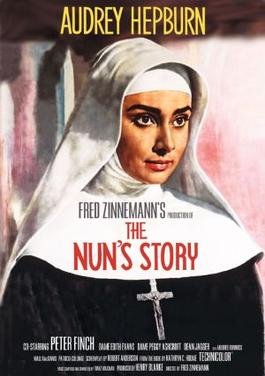Historical Context and Production Background
“The Nun’s Story” premiered on June 18th, 1959, in New York City, marking a significant event in the cinematic landscape. The film is an adaptation of Kathryn Hulme’s acclaimed novel, which had captured readers’ imaginations with its poignant narrative and complex characters. Hulme’s book, based on the real-life experiences of former nun Marie Louise Habets, offered a profound exploration of faith, duty, and personal conflict, elements that resonated deeply with audiences of the time. Prior to its adaptation, the novel had already garnered significant praise and established a devoted readership, setting a high bar for its film counterpart.
The production of “The Nun’s Story” was helmed by director Fred Zinnemann, known for his meticulous craftsmanship and ability to elicit powerful performances. Casting Audrey Hepburn as the lead was a pivotal decision that contributed immensely to the film’s success. Hepburn, already an established star, brought a nuanced portrayal of Sister Luke, balancing vulnerability and strength in a way that captivated audiences and critics alike. Zinnemann’s vision for the film emphasized authenticity and depth, aligning perfectly with the novel’s intricate exploration of personal and institutional struggles.
Filming “The Nun’s Story” presented numerous challenges, from recreating the austere settings of a convent to capturing the emotional intensity of the narrative. The production team overcame these hurdles through meticulous planning and a commitment to staying true to the source material. The film’s cinematography, handled expertly by Franz Planer, played a crucial role in conveying the story’s emotional and thematic depth. The authenticity of the settings and the emotional gravitas of the performances were key highlights that contributed to the film’s critical acclaim.
In the broader context of 1950s Hollywood, “The Nun’s Story” stood out for its thematic focus on personal struggle and institutional critique. This was a period marked by films that delved into individual conflicts and societal norms, reflecting the era’s evolving cultural and moral landscape. Historical reviews, such as those from the New York Times and Variety, praised the film for its profound narrative and exceptional performances, further cementing its status as a cinematic milestone. The premiere of “The Nun’s Story” on June 18th, 1959, in New York City, remains a significant moment in film history, illustrating the enduring power of storytelling and the impact of thoughtful, well-crafted cinema.
Critical Reception and Legacy
The premiere of “The Nun’s Story” on June 18th, 1959, in New York City was met with widespread acclaim, signaling a significant moment in cinematic history. Upon its release, critics praised the film for its compelling narrative and nuanced portrayal of religious life. Prominent publications such as The New York Times lauded Audrey Hepburn’s performance, describing it as a career-defining role that showcased her depth and range as an actress. The film’s director, Fred Zinnemann, was commended for his sensitive and respectful handling of the source material, which was adapted from Kathryn Hulme’s novel of the same name.
Following its premiere, “The Nun’s Story” received eight Academy Award nominations, including Best Picture, Best Director, and Best Actress for Hepburn. Although it did not secure a win in these categories, the nominations underscored the film’s artistic merit and solidified Hepburn’s standing as one of Hollywood’s premier talents. The film’s success also contributed to the growing trend of biographical and religious dramas in the late 1950s and early 1960s, influencing future productions both thematically and stylistically.
Over the decades, “The Nun’s Story” has maintained its status as a poignant and thought-provoking film. Modern-day retrospectives highlight its enduring relevance, often pointing to its introspective exploration of faith, duty, and personal conflict. Scholarly analyses have examined the film’s cultural impact, noting how it challenged contemporary perceptions of religious life and offered a more humanized view of its characters. The film’s legacy is further evidenced by its continued presence in discussions about classic cinema and its influence on subsequent films within the genre.
In today’s cinematic landscape, “The Nun’s Story” is frequently referenced as a benchmark for religious dramas and biopics, demonstrating the lasting impact of its premiere on June 18th, 1959, in New York City. Its nuanced storytelling and powerful performances continue to resonate with audiences and critics alike, ensuring its place in the annals of film history.

